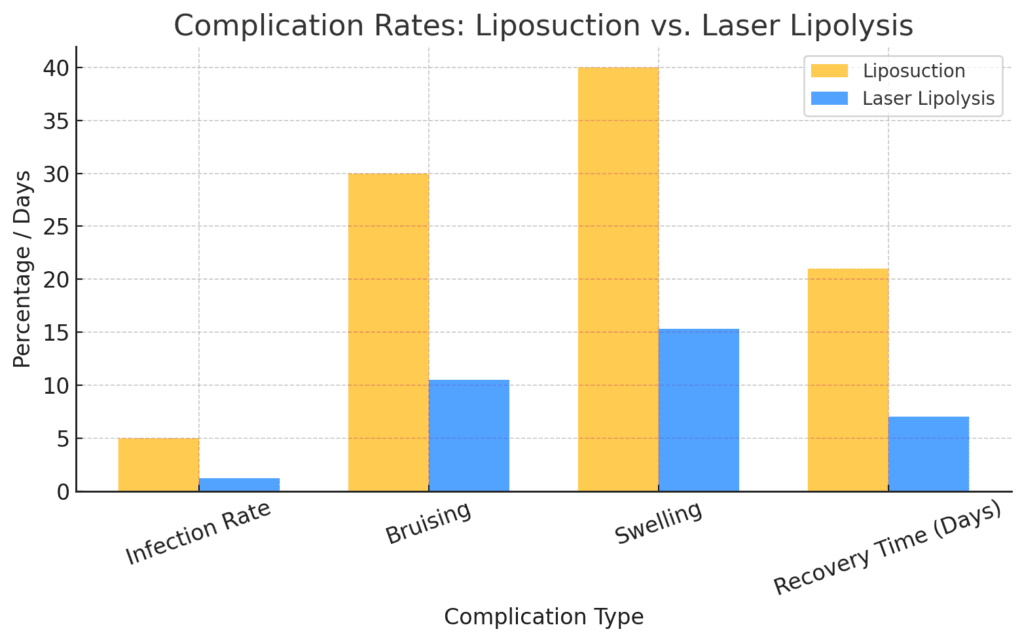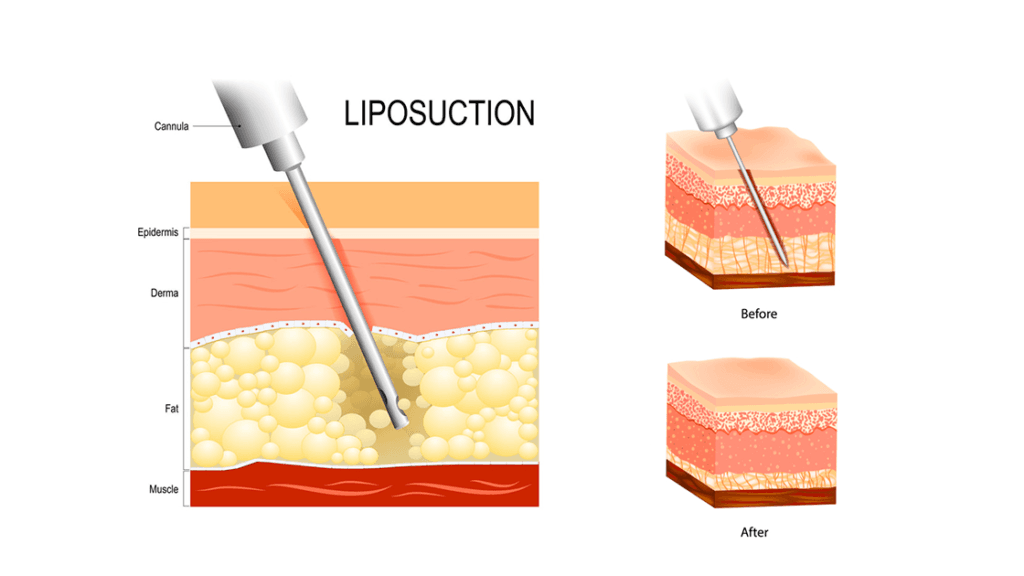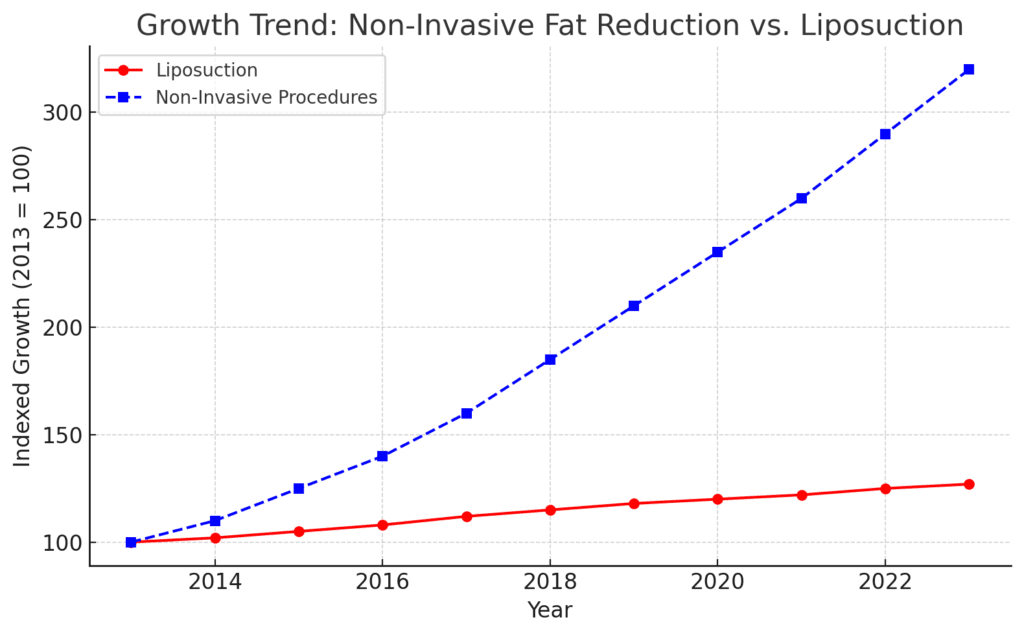1. The Evolution of Fat Reduction
1.1 The Rising Demand for Body Contouring
With an increasing focus on aesthetic enhancements and body confidence, the global body contouring market is projected to reach $9.1 billion by 2031, growing at a CAGR of 14.2% (Allied Market Research). The demand for non-surgical fat reduction procedures like laser lipolysis is fueled by:
A preference for minimally invasive and non-invasive treatments
Concerns over the downtime and risks of traditional liposuction
Advances in laser-based technologies improving safety and efficacy
1.2 Understanding Stubborn Fat: Why It Won’t Budge
Stubborn fat, primarily composed of subcutaneous adipose tissue (SAT), is resistant to diet and exercise due to:
Hormonal factors (e.g., estrogen promotes fat storage in hips/thighs)
Fat cell composition: White adipose tissue (WAT) is harder to break down
Reduced blood flow, making it less responsive to metabolic changes
1.3 The Shift from Liposuction to Laser Fat Removal
Traditional liposuction remains a gold standard for fat removal, but laser lipolysis is gaining ground due to: Less downtime (hours vs. weeks), reduced bruising and swelling, skin-tightening benefits from collagen stimulation.
2. Laser Lipolysis Explained: How It Melts Away Fat
2.1 The Science Behind Laser Fat Reduction
Laser lipolysis is a minimally invasive fat reduction technique that employs a 1064nm wavelength laser, such as the PowerSculp 1064nm laser system, to selectively target adipose tissue. This process, known as selective photothermolysis, raises the temperature of fat cells to 42–47°C, inducing irreversible cell damage and apoptosis.
Key Mechanisms of Laser Lipolysis:

Adipocyte Disruption: The thermal energy causes the rupture of adipocyte membranes, leading to gradual fat cell death.
Collagen Remodeling: Heat stimulates fibroblast activity, promoting neocollagenesis and skin tightening.
Enhanced Lymphatic Drainage: Destroyed fat cells are metabolized and eliminated through the lymphatic system over several weeks.
2.2 Key Benefits of Laser Lipolysis Over Traditional Methods
| Feature | Laser Lipolysis | Traditional Liposuction |
| Invasiveness | Minimally invasive (small incisions) | Invasive (large cannulas) |
| Fat Removal Rate | 0~24% reduction per session | 2-5 liters per procedure |
| Downtime | 1-2 days | 1-2 weeks |
| Skin Tightening | Yes, stimulates collagen production | No, may cause sagging |
| Pain Level | Mild discomfort | Moderate to severe |
| Scarring | Minimal | Possible |
Laser lipolysis is particularly beneficial for patients with mild-to-moderate fat deposits who want skin tightening along with fat reduction. The additional collagen stimulation helps prevent post-treatment skin laxity, a common issue after liposuction.
2.3 Limitations and Considerations of Laser Lipolysis
Despite its advantages, laser lipolysis has certain limitations:
Not Suitable for Large Volume Fat Reduction: Traditional liposuction is more effective for removing large fat deposits (>5 liters).
Multiple Sessions May Be Required: Patients may need 2-3 treatments for optimal results.
BMI Restriction: Best for individuals with BMI <30; not suitable for patients with morbid obesity.
Delayed Fat Clearance: Fat metabolism takes 4-6 weeks, meaning results are gradual compared to the immediate effects of liposuction.

3. Liposuction: The Surgical Standard for Fat Removal
3.1 How Liposuction Works: The Fat Suction Process
Liposuction remains the gold standard for fat removal, using mechanical aspiration to extract large volumes of fat. The process involves:
Tumescent Infiltration: A solution of lidocaine, epinephrine, and saline is injected into the treatment area to minimize pain, bleeding, and swelling.
Fat Mobilization: A cannula is inserted, breaking up fat deposits via manual manipulation or power-assisted liposuction (PAL).
Fat Extraction: Suction-assisted liposuction (SAL) removes 2-5 liters of fat in a single session.

3.2 The Pros and Cons of Liposuction
Advantages:
- Removes significant fat volume in one session.
- Suitable for high BMI individuals (>30).
- Permanent fat reduction with predictable results.
Disadvantages:
- Higher risk of complications: Infection, seroma, hematoma.
- Longer recovery: Swelling and bruising last 4-6 weeks.
- Potential for post-op skin laxity.
3.3 Why Some People Are Moving Away from Liposuction
The global market for non-invasive body contouring is projected to grow at CAGR 14.2%. While liposuction remains effective, patient preferences are shifting due to:
Minimally invasive alternatives with faster recovery.
Advances in non-surgical fat reduction (e.g., laser lipolysis, cryolipolysis).
Rising demand for skin tightening treatments post-fat reduction.

4. Laser Lipolysis vs. Liposuction: A Head-to-Head Comparison
Both laser lipolysis and liposuction are effective fat reduction treatments, but they differ significantly in their mechanisms, effectiveness, recovery time, and cost. Understanding these differences is crucial when deciding which procedure is right for an individual.
4.1 Which Treatment Removes More Fat?
Liposuction remains the gold standard for fat removal when a significant volume reduction is required. Studies indicate that liposuction can remove up to 4-5 liters (approximately 10 pounds) of fat per session. In contrast, laser lipolysis is designed for smaller, localized fat reduction, typically reducing 20-25% of fat in the treated area per session. Scientific Data Comparison:
Liposuction: Removes fat through suction-assisted lipoplasty, yielding immediate and dramatic results.
Laser Lipolysis: Uses laser energy to break down fat cells, which are then metabolized by the body over several weeks.
4.2 Recovery, Pain, and Side Effects
Recovery Time:
- Liposuction: Requires 2-4 weeks for full recovery, with compression garments worn for at least a month.
- Laser Lipolysis: Patients resume normal activities within 1-3 days, with no major post-procedure restrictions.
Pain and Discomfort:
- Liposuction: Moderate to severe pain, bruising, and swelling are common post-surgery.
- Laser Lipolysis: Mild discomfort, with minimal bruising and swelling.
Side Effects:
- Liposuction: Risks include infection, contour irregularities, and seromas (fluid accumulation).
- Laser Lipolysis: Minimal risk, though some patients report temporary redness, swelling, or slight burns.
5. Choose one According to Individuals
The choice between laser lipolysis and liposuction depends on individual goals, health status, and lifestyle.
5.1 The Ideal Candidate for Laser Lipolysis
BMI under 30
Small, localized fat deposits (e.g., abdomen, flanks, thighs, double chin)
Prefers non-surgical options with minimal downtime
Skin elasticity is good to moderate
5.2 The Ideal Candidate for Liposuction
BMI 30-35, needing larger fat reduction
Requires dramatic reshaping in multiple body areas
Has stubborn fat resistant to diet and exercise
Accepts longer recovery and potential surgical risks
5.3 Can Laser Lipolysis Fully Replace Liposuction?
Laser lipolysis cannot fully replace liposuction, particularly for individuals who require significant fat removal. While laser lipolysis effectively breaks down and reduces small to moderate fat deposits, it lacks the capacity to remove large volumes of fat in a single session. However, laser lipolysis serves as an excellent alternative for those seeking body contouring with minimal invasiveness. Unlike liposuction, which requires incisions and suction, laser lipolysis utilizes controlled thermal energy to liquefy fat cells, which are then naturally eliminated by the body’s lymphatic system. This process results in less trauma, reduced downtime, and a lower risk of complications such as excessive bleeding or scarring.
Furthermore, laser lipolysis provides additional skin-tightening benefits due to collagen stimulation, making it an appealing option for individuals concerned about skin laxity post-fat reduction. That being said, for patients with significant fat deposits or those seeking immediate and dramatic reshaping, traditional liposuction remains the more effective solution.
Ultimately, the choice between laser lipolysis and liposuction depends on individual goals, body composition, and medical recommendations. For those prioritizing safety, quicker recovery, and mild to moderate fat reduction, laser lipolysis is a viable option. However, for those requiring substantial fat removal, liposuction remains the gold standard.
6. FAQs: Professional Insights on Laser Lipolysis vs. Liposuction
Q1: Which procedure is more effective for long-term fat reduction?
Both laser lipolysis and liposuction provide permanent fat cell removal, but liposuction removes a larger fat volume in a single session. Laser lipolysis requires multiple treatments for optimal results. Long-term effectiveness depends on diet, exercise, and metabolism.
Q2: How does laser lipolysis stimulate collagen production?
Laser lipolysis utilizes 1064nm wavelengths to induce controlled thermal injury, stimulating neocollagenesis and elastin remodeling. This effect results in skin tightening, reducing post-treatment sagging.
Q3: What are the risks associated with liposuction vs. laser lipolysis?
Liposuction risks: Seromas, hematomas, infection, fat embolism, and postoperative contour irregularities (10-15% incidence).
Laser lipolysis risks: Minor swelling, temporary erythema (5-7% incidence), and mild burns if energy parameters are miscalculated.
Q4: How do complication rates compare between the two procedures?
A 2022 clinical review published in the Journal of Cosmetic Dermatology found that liposuction has a complication rate of 5-15%, while laser lipolysis exhibits a lower complication rate of 2-5%, primarily due to its non-invasive nature.
Q5: Can laser lipolysis be used for high-BMI patients?
No. Laser lipolysis is most effective for patients with a BMI < 30 and localized adiposity. For individuals with higher BMI (30-35) or extensive fat accumulation, liposuction is the preferred option.
Q6: What are the metabolic implications of fat removal?
Studies indicate that fat removal alters adipokine secretion, influencing insulin sensitivity and lipid metabolism. However, neither procedure serves as a treatment for obesity or metabolic syndrome.
Q7: How soon do results become visible for laser lipolysis?
Unlike liposuction, which provides immediate fat reduction, laser lipolysis requires 4-12 weeks as the lymphatic system gradually metabolizes liquefied fat.
Q8: Is there a difference in fibrosis or skin irregularities post-treatment?
Liposuction patients may experience fibrotic adhesions and uneven fat removal, necessitating revision procedures (8-12% cases). Laser lipolysis minimizes fibrosis due to heat-induced tissue remodeling, offering smoother post-treatment contours.
7. References: Evidence-Based Clinical Studies & Expert Sources
Laser-Assisted Lipolysis Versus Surgical Fat Removal:
https://www.mdpi.com/2079-9284/11/5/164
Safety of Large-Volume Liposuction in Aesthetic Surgery:
https://academic.oup.com/asj/article/41/9/1040/6012397
Laser Lipolysis: An Update:
https://jcadonline.com/laser-lipolysis-an-update
Comparison of Complications in Isolated Aesthetic Liposuction Techniques:
https://link.springer.com/article/10.1007/s00238-024-02268-0







